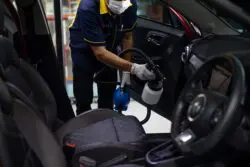
Ensuring a safe and healthy environment within commercial spaces is paramount, especially when faced with biohazardous situations. Biohazards, ranging from bodily fluids to hazardous chemicals, pose significant risks to both employees and customers. This comprehensive guide aims to shed light on the crucial safety protocols necessary for effective biohazard cleanup in commercial spaces.
Commercial establishments, including offices, retail spaces, and industrial units, encounter biohazardous incidents that demand prompt and meticulous attention. Understanding and implementing proper safety measures not only protect individuals but also safeguard the reputation of the business. In this article, we will delve into various aspects of biohazard cleanup, providing in-depth insights into safety protocols that every commercial space should adopt.
See also our post on Floor Matting Solutions for Commercial Entryways
Identification of Biohazards
Recognizing Biohazardous Materials
Identifying biohazardous materials is the first step in ensuring a safe environment. These materials encompass a broad spectrum, including blood, bodily fluids, chemicals, and even certain medical waste. Employees should undergo training to recognize and differentiate these materials from regular waste.
Understanding Biohazard Categories
Biohazards are categorized into different levels based on their potential risk. Level 1 biohazards pose minimal risk, while Level 4 biohazards are highly dangerous. It’s imperative for commercial spaces to comprehend these categories to tailor their cleanup protocols accordingly.
Utilizing Proper Labels and Signage
Clear and visible labels play a crucial role in preventing accidental exposure. Biohazard symbols, color-coded containers, and explicit signage guide employees and customers, minimizing the risk of mishandling biohazardous materials.
Establishing Communication Protocols
Establishing effective communication channels within the commercial space is essential. Employees should be well-informed about reporting procedures and the importance of prompt reporting when encountering potential biohazardous situations.
Collaborating with Professionals
In complex biohazard scenarios, seeking the assistance of professional cleanup services is vital. Establishing partnerships with certified biohazard cleanup companies ensures that the cleanup process adheres to industry standards and regulations.
Personal Protective Equipment (PPE)
Mandating PPE Usage
Employees involved in biohazard cleanup must be equipped with appropriate Personal Protective Equipment (PPE). This includes gloves, masks, goggles, and specialized clothing. Clear guidelines on PPE usage should be outlined and strictly enforced.
Providing Training on PPE
Simply providing PPE is not enough; comprehensive training on the correct usage, removal, and disposal of PPE is imperative. This training ensures that employees understand the importance of each component and follow proper protocols to minimize exposure.
Regular Inspection of PPE
Regular inspections of PPE kits should be conducted to identify any signs of wear or damage. Damaged equipment should be promptly replaced to maintain the effectiveness of the protective measures.
Accessible PPE Stations
Strategic placement of PPE stations throughout the commercial space ensures quick and easy access for employees. Stations should be well-stocked, and employees should be aware of their locations.
Emergency PPE Kits
In addition to standard PPE stations, commercial spaces should have emergency PPE kits readily available. These kits can be crucial in unexpected biohazard situations, providing immediate protection until professional cleanup services arrive.
See also our post on Green Cleaning for Commercial Properties: Eco-Friendly Solutions
Cleanup Procedures
Establishing Cleanup Protocols
Clearly defined cleanup protocols should be established and communicated to all employees. These protocols should detail step-by-step procedures, including containment, removal, and disinfection, to ensure a systematic approach to biohazard cleanup.
Utilizing Absorbent Materials
Biohazardous spills require immediate attention. Having absorbent materials such as spill kits on hand facilitates quick containment and cleanup, preventing the spread of contaminants.
Proper Disposal Methods
Disposing of biohazardous materials follows strict regulations. Commercial spaces must adhere to these regulations, utilizing approved containers and disposal methods. Employees should be trained on the proper segregation and disposal of biohazardous waste.
Thorough Cleaning and Disinfection
The cleanup process extends beyond removal, emphasizing thorough cleaning and disinfection of affected areas. Using EPA-approved disinfectants and following recommended contact times ensures the elimination of pathogens, promoting a safe environment.
Post-Cleanup Inspection
After the cleanup process, a thorough inspection is essential to ensure no traces of biohazards remain. This step involves validating the effectiveness of the cleanup and identifying any areas that may require additional attention.
Employee Training and Awareness
Continuous Training Programs
Biohazard cleanup training should not be a one-time affair. Regular training programs keep employees updated on the latest safety protocols, reinforcing the importance of vigilance and adherence to procedures.
Simulated Biohazard Drills
Conducting simulated biohazard drills prepares employees for real-life situations. These drills enhance response times, familiarize employees with emergency procedures, and instill confidence in handling biohazard cleanup.
Raising Awareness
Creating awareness among employees about the potential biohazards they may encounter fosters a proactive approach. Regular communication through posters, seminars, and safety meetings reinforces the significance of adhering to safety protocols.
Reporting Mechanisms
Establishing a straightforward reporting mechanism encourages employees to promptly report biohazardous incidents. An efficient reporting system aids in swift response and minimizes the impact of biohazard exposures.
Employee Assistance Programs
Biohazard cleanup can be emotionally challenging. Implementing employee assistance programs provides necessary support for those involved in cleanup, addressing any psychological or emotional impact.
Regulatory Compliance
Familiarity with Regulations
Commercial spaces must be well-versed in local, state, and federal regulations regarding biohazard cleanup. Compliance with these regulations is not only a legal requirement but also crucial for maintaining a safe and responsible business environment.
Documented Compliance Procedures
Maintaining documented procedures for regulatory compliance is essential. These documents should outline how the commercial space adheres to specific biohazard cleanup regulations, showcasing a commitment to safety.
Regular Audits and Inspections
Conducting regular audits and inspections ensures ongoing compliance with biohazard cleanup regulations. Identifying and addressing potential issues proactively prevents legal complications and promotes a culture of safety.
Legal Consequences of Non-Compliance
Non-compliance with biohazard cleanup regulations can lead to severe legal consequences. Fines, lawsuits, and damage to the business’s reputation are potential outcomes, emphasizing the importance of stringent adherence to regulations.
Engaging Legal Counsel
In complex regulatory environments, commercial spaces may benefit from engaging legal counsel specializing in biohazard cleanup regulations. Legal advice ensures a thorough understanding of requirements and helps in crafting robust compliance strategies.
Communication Protocols
Internal Communication
Effective communication within the organization is critical during biohazard cleanup. Clear communication lines ensure that all employees are informed of the situation, understand their roles, and can follow safety protocols without confusion.
External Communication
Externally, communication is equally vital. Alerting relevant authorities, such as local health departments, ensures a coordinated response. Communicating transparently with customers and the public helps maintain trust and mitigates potential reputational damage.
Media Relations
In the event of a significant biohazard incident, managing media relations becomes crucial. Having a designated spokesperson and a prepared statement helps control the narrative, emphasizing the commitment to safety and responsible cleanup.
Employee Support Services
Providing support services for affected employees, including counseling and medical assistance, demonstrates a commitment to their well-being. Open communication channels allow employees to voice concerns and seek assistance without fear of reprisal.
Reassuring Stakeholders
Timely and transparent communication reassures stakeholders, including customers, suppliers, and investors. Keeping these parties informed about the situation and the steps taken for cleanup fosters trust and maintains positive business relationships.
See also our post on Floor Matting Solutions for Commercial Entryways
Conclusion
Biohazard cleanup in commercial spaces necessitates a multimodal strategy based on extensive safety protocols. Every component—from detecting biohazards to putting appropriate cleanup procedures in place, following rules, and communicating clearly—contributes significantly to the upkeep of a safe and secure environment. By emphasizing employee training, regulatory compliance, and open communication, commercial spaces can not only manage biohazard situations successfully but also protect the health of their employees and the reputation of their company. After all, a dedication to safety today guarantees a thriving and resilient business tomorrow.







